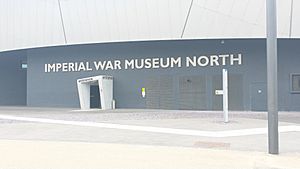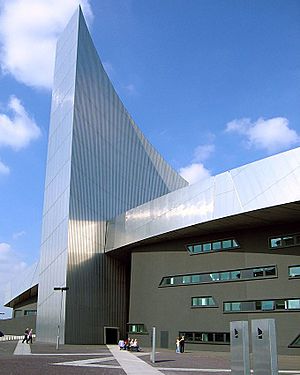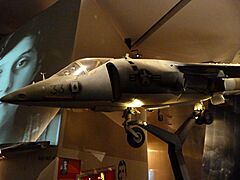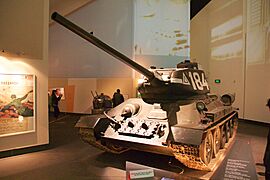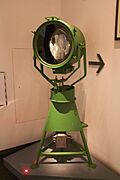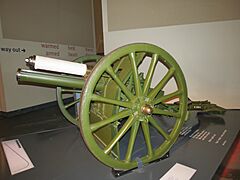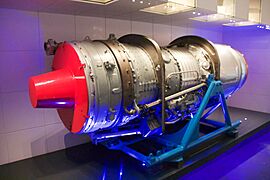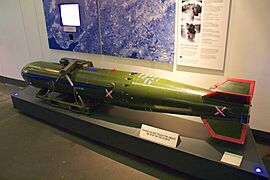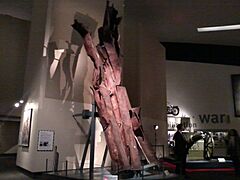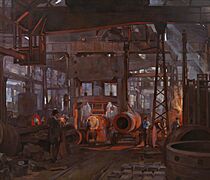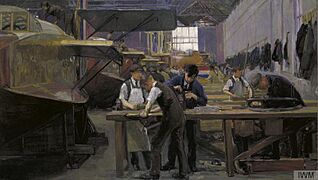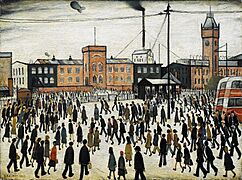Imperial War Museum North facts for kids
 |
|
| Established | 5 July 2002 |
|---|---|
| Location | The Quays Trafford Wharf Road Trafford Park Greater Manchester England |
| Type | War museum |
| Visitors | 244,564 (2019) |
| Public transit access | Imperial War Museum |
| Imperial War Museums | |
|
|
The Imperial War Museum North, often called IWM North, is a special museum in Greater Manchester, England. It's one of five museums that are part of the Imperial War Museum family. This museum helps us understand how modern wars and conflicts have affected people and society. It was the first Imperial War Museum to open in the north of England.
The museum is located right next to the Manchester Ship Canal in Trafford Park. This area was very important during World War II because many factories there made things for the war. Because of this, Trafford Park was heavily bombed in 1940 during the Manchester Blitz. Today, the area is a lively cultural spot, with places like the Lowry and MediaCityUK nearby.
The unique building was designed by a famous architect named Daniel Libeskind. It opened its doors in July 2002 and quickly became very popular. The museum has a main exhibition that shows events in order and also explores different themes. There are also amazing hourly shows with pictures and sounds projected all around the gallery. Plus, the museum often has new, temporary exhibitions. It's a great place to learn about history, and admission is free!
Contents
Building the Museum
In the 1990s, the Imperial War Museum wanted to open a new branch in the north of England. Many towns offered places for the museum. Eventually, the area of Trafford in Greater Manchester was chosen.
Trafford Park was a perfect choice because of its strong connection to World War II. During the war, factories in this area built Avro Lancaster bombers and Rolls-Royce Merlin engines for Royal Air Force planes. By 1945, about 75,000 people worked there. Because it was so important, Trafford Park was heavily bombed, especially during the Manchester Blitz in December 1940. Over two nights, 684 people lost their lives. The museum received permission to build in Trafford Park in 1999.
Amazing Architecture
A competition was held in 1997 to find the best design for the new museum. The winner was Daniel Libeskind, an architect from Berlin. Daniel Libeskind was born in Poland in 1946, and his family suffered a lot during World War II. Many of his relatives were killed in The Holocaust. This was his first building in the United Kingdom.
Libeskind wanted to create a building that would make visitors feel something deep inside. He imagined the museum as a "shattered globe" – like the Earth broken into pieces by conflict. These pieces, called "shards," represent air, earth, and water. Each shard has a different purpose in the museum.
- The Air Shard is 55 meters (about 180 feet) tall and forms the museum's entrance. It used to have a viewing balcony with great views of the Manchester Ship Canal and the city skyline.
- The Earth Shard holds the main exhibition areas.
- The Water Shard has a cafe where you can look out at the canal.

The museum cost £28.5 million to build. It was funded by different groups, including the European Union, English Partnerships, and Trafford Council. A local company called The Peel Group gave £12.5 million, which was a huge amount for a cultural project in the UK at the time. Construction started in January 2000, and the museum opened on July 5, 2002.
What You Can See
The main exhibitions are in the museum's large gallery space, inside the earth shard. This area has a curved floor, like the curve of the Earth. It's a huge, dramatic space where you can see many large objects.
- A Russian T-34 tank.
- A United States Marine Corps AV-8A Harrier jet.
- A 13-pounder field gun, which fired the British Army's first shot in World War I.
Around the gallery, there are tall displays called "timestacks" that show smaller items. Some of these items visitors can even touch! There's also a 7-meter (23-foot) piece of twisted steel from the World Trade Center in New York, which was damaged during the September 11 attacks.
- Objects in the IWM north collection
-
A Soviet T-34 tank
-
Wreckage from the September 11 attacks on New York's World Trade Center
The museum also shows artworks by official war artists. These artists were asked to create pictures of Britain during the world wars. Some famous paintings include Building Flying-Boats by Flora Lion, The 'L' Press. Forging the Jacket of an 18-inch Gun by Anna Airy, and Going to Work by L. S. Lowry.
- War artists displayed at IWM north
-
Going to Work by L. S. Lowry (1943)
The Big Picture Show
The walls of the gallery are used as giant screens for hourly shows called the "Big Picture." These shows explore different topics about modern conflicts. They use up to 1,500 images from the Imperial War Museum's huge collection of photographs. Digital projectors were installed in 2011, making the shows even better. The images are combined with personal stories from the museum's sound archive, making the experience very powerful.
Temporary Exhibitions
There's also a separate gallery for temporary exhibitions. These shows change regularly and have included art exhibitions from the museum's collection, focusing on art from the First and Second World Wars, and works by female war artists.
The WaterWay, a path connecting the earth and water parts of the museum, is used for smaller art or photo exhibitions.
Outside the museum, you can see an ex-Iraqi Ground Forces T-55 tank. This tank was captured by the Royal Engineers during the Iraq War in 2003. Before that, an Iraqi ZSU-23-4 anti-aircraft gun was on display, moved from Imperial War Museum Duxford in 2007.
Volunteer Program
Since it opened in 2002, the Imperial War Museum North has had a successful volunteer program. This program helps local people, especially those who might be struggling to find work or feel left out. Volunteers learn about cultural heritage and gain new skills, which helps them feel more confident and find jobs.
In return, the volunteers help out in the museum's public areas, welcoming visitors and assisting them. In 2007, the museum started the "in Touch" volunteer program with Manchester Museum. This program has been praised by the government as a great example of how museums can help their communities.
See also
 In Spanish: Imperial War Museum North para niños
In Spanish: Imperial War Museum North para niños


